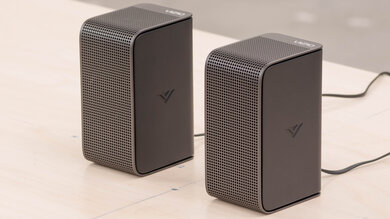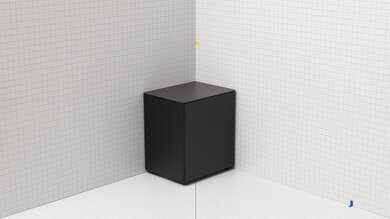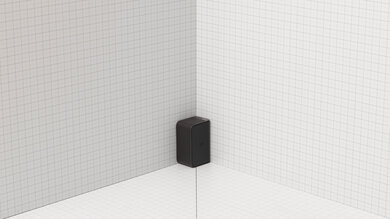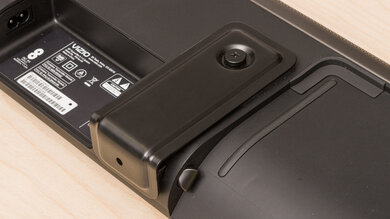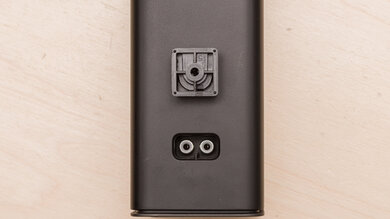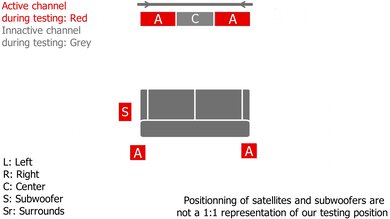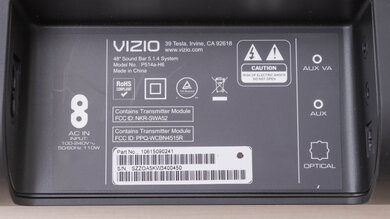The Vizio Elevate soundbar is a 5.1.4 setup with a unique design. When you watch Dolby Atmos or DTS:X content, the sides of the bar automatically rotate upwards, resulting in a wide and immersive-sounding soundstage. You can rotate the sides upwards when you listen to other types of audio content, too, or you can turn it off entirely. Right out of the box, the bar's sound profile is bass-heavy, and vocals and lead instruments are mostly clear but also quite bright due to the recessed treble. That said, you can use its bass and treble adjustments to customize its sound based on your preferences.
Our Verdict
The Vizio Elevate 5.1.4 is good for mixed usage. This versatile soundbar has a balanced mid-range that reproduces voices in podcasts and TV shows with clarity. There's some extra boom in the bass range that helps you feel the excitement in bass-heavy music and action-packed movies, which some users will want to tame by adjusting the bass level. Thanks to its discrete satellites, the action in your favorite movies seems to take place all around you, resulting in an immersive listening experience.
-
Bluetooth, Wi-Fi, and Chromecast built-in compatibility.
-
Four EQ presets.
-
Wide, focused soundstage.
-
No graphic EQ.
-
Some compression at max volume.
The Vizio Elevate soundbar is good for vocal-centric content like TV shows. This 5.1.4 setup comes with a discrete center channel, so voices accurately anchor to pinpoint locations in the soundstage. With its balanced mids, voices reproduce clearly and there's even a treble adjustment feature and a dialogue enhancement mode to help make voices more clear and crisp in your audio.
-
Dialogue enhancement feature.
-
Bluetooth, Wi-Fi, and Chromecast built-in compatibility.
-
Poor latency performance via eARC and HDMI In.
The Vizio Elevate 5.1.4 is decent for music. It can reproduce vocals and lead instruments pretty clearly out of the box, though higher frequencies sound a little harsh due to the prominent treble range. There's extra boom in the bass range that helps you feel the rumble in bass-heavy genres like EDM and hip-hop, too. If you prefer a more neutral sound, fortunately, bass and treble adjustments are also available. However, you won't find a graphic EQ to help you customize the bar throughout the range.
-
Bluetooth, Wi-Fi, and Chromecast built-in compatibility.
-
Four EQ presets.
-
No graphic EQ.
-
Some compression at max volume.
The Vizio Elevate soundbar is good for movies. Thanks to its rotating sides, it has a wide soundstage with good focus, making it seem like sound objects are coming from a pinpoint location. For example, cars in a chase scene seem to race past you from one side of the screen to another. It's a decent choice for surround sound, too, and it also supports Dolby Atmos content.
-
Dialogue enhancement feature.
-
Four EQ presets.
-
Wide, focused soundstage.
-
Some compression at max volume.
-
Poor latency performance via eARC and HDMI In.
- 7.5 Mixed Usage
- 7.6 Dialogue/TV Shows
- 7.4 Music
- 7.5 Movies
Changelog
-
Updated Mar 03, 2025:
We referenced the Vizio Elevate SE SL512X-0806 in the Audio Format Support: Optical box.
- Updated Aug 29, 2024: Updated the Stereo Dynamics results with new methodology from Test Bench 1.3. Added text to Audio Latency: ARC, Audio Latency: HDMI In, and Audio Latency: Optical boxes.
- Updated Aug 28, 2024: We've converted this review to Test Bench Update 1.3. If applicable, we've retested stereo sound based on the manufacturer's recommendations. Additionally, we've expanded our audio latency tests to the following boxes: Audio Latency: ARC, Audio Latency: HDMI In, and Audio Latency: Optical. You can see the full changelog here.
- Updated Jun 07, 2023: Converted to Test Bench 1.2. Updated the results for audio format support via ARC/eARC, HDMI In, and Optical. Added Video Passthrough to TV results as well.
- Updated Mar 13, 2023: Added cable lengths to In The Box.
Check Price
Differences Between Sizes And Variants
The Vizio Elevate soundbar comes in one color variant: Black. You can see the label for the model we tested here.
If you come across another variant, let us know in the comments.
Compared To Other Soundbars
The Vizio Elevate sound bar is a 5.1.4 setup with a unique design that allows you to rotate the left and right sides of the bar to create a wide, focused soundstage. It's a versatile soundbar that supports Dolby Atmos and DTS:X content. However, compared to other premium bars on the market, its default sound profile is a bit bass-heavy and can sound sharp in the treble range. There's no room correction feature, either.
If you want to see more soundbars, check out our recommendations for the best soundbars, the best Dolby Atmos soundbars, and the best 5.1 soundbars.
The Vizio Elevate SE SL512X-0806 is a more affordable entryway into Vizio's Elevate lineup of soundbars than the top-of-the-line Vizio Elevate. The cheaper sibling loses video passthrough to TV, WiFi playback, optical inputs, a full HDMI input port, and a remote. Whether you need those features is a question only you can answer. But if you don't, the cheaper Elevate SE SL512X-0806 is well worth considering as it performs very similarly to the more expensive flagship in terms of audio reproduction.
The Vizio Elevate is a better soundbar than the Sonos Arc. The Sonos has a bright sound profile that lacks a bit of bass, especially compared to the Vizio's bass-heavy sound profile. The Vizio has a Full HDMI In port that supports 4k passthrough, unlike the Sonos. You can check out the Sonos Arc with Sub + One SL Speakers to compare its performance with its full setup.
Depending on your listening habits, you may prefer either the Vizio Elevate or the Vizio M Series M512a-H6. The Elevate is better built and has a better Atmos performance. It supports more wireless playback options. The M Series has less compression at max volume, so your audio sounds cleaner during louder listening sessions.
JBL Bar 9.1 is a better soundbar than the Vizio Elevate. The JBL has a somewhat more balanced default sound profile, so it's suitable for a wider variety of audio content. It also offers better center channel and surround performance, though both bars have a similarly wide soundstage. It also has a room correction feature and is compatible with Apple AirPlay, unlike the Vizio. The Vizio comes with more sound enhancement options, like bass and treble adjustment and a dialogue enhancement mode.
The Vizio Elevate and the Vizio M Series M51a-H6 are both very versatile soundbars; depending on your listening habits, you may prefer one over the other. The Elevate has a unique design with sides that rotate upwards to create a more immersive listening experience. It's better built, has a better stereo soundstage performance, and supports Wi-Fi and Chromecast built-in. However, the M Series has better surround performance, center channel accuracy, and lower latency.
The Vizio Elevate is a more premium alternative to the Vizio M Series Elevate M512E-K6. It has a better soundstage, and since its satellites come with additional up-firing drivers, it's a better choice for listening to Dolby Atmos content. Both bars offer the same sound enhancement features, but the original Elevate has more wireless playback options. The M Series is designed to be a more affordable alternative, and while its default sound is more neutral than the original Elevate, it can't reproduce quite as much low bass.
Depending on your listening habits, you may prefer either the Sonos Arc with Sub + One SL Speakers or the Vizio Elevate. The Sonos is better built, has a more balanced sound profile, and has a room correction feature. However, the Vizio comes with a few EQ presets to toggle between, and its built-in Wi-Fi and Chromecast capabilities will endear it to users who like to stream content wirelessly. The Vizio also has a Full HDMI In port, so it supports 4k passthrough, which is great if you plan on using your soundbar as a hub between a PC/console and TV.
For most uses, the Vizio Elevate is better than the Nakamichi Shockwafe Ultra 9.2Ch. The Vizio is a 5.1.4 setup with a better soundstage and more wireless playback options. That said, the Nakamichi has better surround and Atmos performances. It also comes with two subwoofers and four satellites, which help create a more immersive sound.
The Bose Smart Soundbar 900 with Speakers + Bass Module and the Vizio Elevate are both premium soundbar setups. The Bose is better built and has better soundstage and surround performances. Some listeners may also prefer its more neutral sound profile out of the box than the Vizio soundbar's bass-heavy sound. That said, unlike the Bose, the Vizio comes with a Full HDMI In port, so you can use it for high-quality passthrough.
Depending on your listening habits, you may prefer either the Vizio Elevate or the Samsung HW-Q950T. The Vizio is better built and offers a better soundstage performance. It has an auto-volume mode and supports more wireless playback options than the Samsung. However, the Samsung gets louder and offers a better surround performance. It comes with a graphic EQ and built-in voice assistant support. Also, some listeners may prefer that it provides a more neutral out-of-the-box sound profile than the Vizio.
The Vizio Elevate is better than the Vizio SB36512-F6. The Elevate is better built, and it has a unique design with sides that rotate upwards to help create a better soundstage performance. It even has more sound enhancement features, like dialogue enhancement mode.
The Bose Smart Soundbar 700 with Speakers + Bass Module is better than the Vizio Elevate for most uses. The Vizio supports Dolby Atmos content and features a full HDMI In port, as well as some EQ presets to help you customize its sound. That said, the Bose is better built and performs better when it comes to sound. Its default frequency response is more balanced, with better soundstage, center channel, and surround performances. Unlike the Vizio, the Bose has built-in voice assistant support, too.
Depending on your listening habits, you may prefer either the Vizio Elevate or the Samsung HW-Q900A. The Vizio is a 5.1.4 setup with discrete satellite speakers that offer better surround performance. Thanks to its unique design with sides that rotate upwards, it also has a better soundstage. That said, the 7.1.2 Samsung comes with more sound enhancement features, like room correction and a graphic EQ. It also has built-in voice assistant support, unlike the Vizio, which requires a third-party device for voice assistant control.
The Vizio Elevate is a slightly better soundbar than the Vizio M Series M51ax-J6. The Elevate is better-built, with a unique design that features rotating sides to help create a better soundstage performance. It also comes with more wireless playback support. However, it exhibits higher latency and a smaller stereo soundstage than the M Series M51ax-J6.
The Vizio Elevate is better than the standalone Bose Smart Soundbar 900 for most uses. The Vizio is a 5.1.4 setup with a dedicated sub and satellites. It has better surround performance and more sound enhancement features like EQ presets. Unlike the Bose, it has a Full HDMI In port for high-quality passthrough. However, the 5.1.2 Bose has a better build quality and built-in voice assistant capabilities. It offers a very impressive performance for a standalone bar, and you can even upgrade it with a sub and satellites.
Test Results
The Vizio Elevate has a very unique design. It's mostly plastic, and there's an aluminum grille on the front to help protect the drivers inside. However, the bar rotates its left and right sides upwards when you play Atmos or DTS:X content for a more immersive sound. You can also set these portions to face upwards instead of outwards at all times. If you like this feature but don't want to pay as much for it, you can also check out the Elevate's more affordable alternative, the Vizio M Series Elevate M512E-K6.
The Vizio Elevate has a great build quality. The bar is mostly plastic, and there's an aluminum grille on the front of the bar that helps protect the drivers. The subwoofer is mostly melamine with a plastic top. Like the bar, the satellites have an aluminum grille to protect the drivers with plastic sides and rear. The materials feel durable and solid, and it's better built than the Vizio M Series M51ax-J6 overall.
- Remote control with 2x AAA batteries
- Stereo RCA to 3.5mm audio cable (4.9 ft / 1.5m)
- 3.5mm to 3.5mm audio cable (4.9 ft / 1.5m)
- HDMI cable (4.9 ft / 1.5m)
- Optical cable (4.9 ft / 1.5m)
- 2x Satellite Speaker audio cables (26 ft / 8m)
- 2x Power cables (8.5 ft / 2.6m and 4.9 ft / 1.5m)
- 4x Wall mount screws
- Wall-mount template
- 2x Wall-mount brackets (Satellite speakers)
- 2x Wall-mount brackets (Soundbar)
- 4x Cable ties
- Manuals
The Vizio Elevate soundbar has a decent stereo frequency response. Out-of-the-box, it has a very bass-heavy sound profile that adds extra thump and punch to your audio, so you feel the bass in action-packed movie scenes and bass-heavy music. Vocals and lead instruments reproduce clearly and accurately, but higher-pitched instruments like cymbals and organs can sound sharp due to the over-emphasized treble range. If you update the bar to firmware version 1.11.07.1, the frequency response remains the same. If you prefer a different sound, you can customize it with its bass and treble adjustments.
The Vizio Elevate comes with bass and treble adjustments and four EQ presets that help you tweak its sound profile to your liking. With the bass set to -10 and the treble set to -1, it has a great stereo frequency response. The sound profile is pretty neutral, meaning vocals and lead instruments are clear and detailed in the mix. There's a touch of extra punch in the bass range, too. Overall, it's suitable for listening to many different types of audio content.
The Vizio Elevate has a great stereo soundstage. The soundstage is perceived as a bit wider than the bar itself, though it doesn't have any features to make it even wider than that. The sound is focused, so objects in the soundstage like voices and footsteps seem to come from an accurate, pinpoint location.
The Vizio Elevate has good stereo dynamics. It gets pretty loud, so you can crank up the volume to fill a large room or play music at a crowded party. There's a bit of compression as you approach max volume, though. For a soundbar with a more clean and pure audio reproduction at max volume, check out the Vizio M Series M51a-H6.
The Vizio Elevate has a decent center channel performance. Its discrete center channel accurately localizes dialogue in movies and TV shows within the soundstage. Its relatively neutral, balanced mid-range means that voices are reproduced clearly and with detail.
The Vizio Elevate has a decent surrounds performance. It has dedicated satellite speakers, resulting in a clear and real representation of surround objects in the soundstage. For example, cars in a chase scene seem to race past you from an accurate, pinpoint location. As for its sound, there's a little extra emphasis in the bass range, so you feel the punch and rumble in action-packed scenes.
The Vizio Elevate has a middling height performance. It uses up-firing speakers on the bar and satellites to bounce sound off the ceiling, creating the illusion of sound coming from above you. This bar also rotates its left and right sides upwards automatically when playing Atmos content to help widen its soundstage. However, the height of sound objects doesn't sound as accurate as discrete down-firing speakers found with home theater setups. You can see a video of how the bar rotates here.
The Vizio Elevate 5.1.4 comes with a decent selection of sound enhancement features. There are four EQ presets to help you customize its sound: Movie, Music, Direct, and Game. There's also a dialogue enhancement feature that can help make voices sound more clear and crisp. You can adjust the sides of the bar to UP, WIDE, or AUTO, and the AUTO setting automatically moves them up when you play Atmos or DTS:X content. Compared to other premium models on the market, like the Samsung HW-Q800B, there's no room correction feature. As a result, it sounds a bit different depending on the room you listen in, but you can use the bass and treble adjustments to make up for this a bit.
The Vizio Elevate comes with many inputs, including HDMI ports that let you use it as a hub between different devices. There are two AUX ports: one for analog audio and a second that you can only use with voice assistant speakers.
The Vizio Elevate supports all audio formats we test for via its ARC port, including Dolby Digital and DTS formats commonly found on Blu-ray discs and streaming platforms.
This soundbar has fantastic audio format support through its Full HDMI port. You can listen to Dolby Digital and DTS content, which you'll commonly find on Blu-ray discs and streaming platforms.
Like most soundbars, the Vizio Elevate supports Dolby Digital and DTS via its Optical port. These formats are commonly found on Blu-ray discs and streaming platforms. If you don't need an optical input port and are looking to save a little money, the Vizio Elevate SE SL512X-0806 is worth considering.
The Vizio Elevate has a poor latency performance via ARC. While some apps and TVs compensate for latency differently, you'll likely need to adjust the AV Delay function to ensure no lip sync errors.
The Vizio Elevate has a poor latency performance via HDMI In. While some apps and TVs compensate for latency differently, you'll likely find yourself turning the AV Delay function to manually compensate for any latency you encounter.
The audio latency performance via optical is okay. However, you can always use the AV delay feature to manually compensate for any latency.
The Vizio Elevate soundbar can passthrough high bandwidth signals, so text looks crisp and clear when you use it as a hub between your PC/console and your TV. If you're using this bar with the newest-gen gaming consoles, you can't passthrough @120Hz 10bit for a totally tear-free gaming experience. That said, it supports Dolby Vision Passthrough, which is handy.
The Vizio Elevate has incredible wireless playback capabilities. You can stream content from your phone or tablet to the bar wirelessly using Bluetooth, Wi-Fi, or Chromecast built-in.
There's a small remote that lets you control the bar's functions. It has a display screen, which has better visibility than other Vizio models like the Vizio SB36512-F6. The Vizio SmartCast app also acts as a remote, so you can control the bar via your smartphone.
The Vizio Elevate doesn't have built-in voice assistant capabilities. However, the manufacturer says that you can plug in a third-party voice assistant device using the AUX VA In port to control the bar using Google Assistant and Amazon Alexa.




